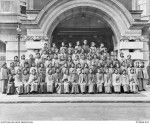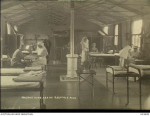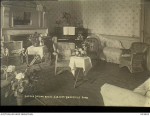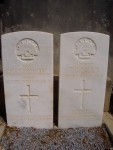SMITH, Winifred Jane
Winifred Jane Smith and her younger sister Elsie Dora Smith joined the Australian Army Nursing Service together and sailed from Australia on active service together on 7 July 1915. Both Winifred and Elsie nursed at 1 Australian Auxiliary Hospital in Harefield, Winifred until December 1917 when she resigned from the AANS on marrying, and Elsie until she was sent to France in October 1917 for the duration of the war.
Winifred’s connection with East Melbourne was as a member of the congregation at St Peter’s Church, Eastern Hill and its Guild of St Barnabas for nurses. She is commemorated on the honour board there under her married name, Winifred J Watson. Elsie appears not to been connected with the parish or East Melbourne.
Before the War
Winifred Smith was the first of five daughters born to Samuel Smith (c1834–1897) and his wife Ann Elizabeth (nee Sutton) (c1849–1898). The couple also had six sons, four of whom survived infancy.
Samuel Smith was born in Fermanagh, (Northern) Ireland in about 1834, and was likely descended from Scottish settlers in or around Enniskillen. It is not clear which one of the various Samuel Smiths arriving in Victoria in the 1850s and 1860s he was. In 1870, he married Ann Elizabeth Sutton, eldest daughter of Job Stephen Sutton and his wife Emma, immigrants to Victoria from Wiltshire in the 1850s. (Victoria, Unassisted Passenger Lists). Ann’s younger sister Emma Frances married Samuel Stuart Smith (1849–1924) in 1878, in all probability a cousin of Samuel Smith.
The Suttons lived in Barkers Creek near Castlemaine in the 1860s. Samuel Smith married Ann Sutton there in 1870. From the 1870s on, both Samuel Smiths appear to have selected land for lease further north in the colony, at Yielima and Yalca near the Murray River. Samuel Stuart moved his interests and family permanently south to Colac in the 1880s, having transferred some land at Yielima to Samuel.
The births of Samuel and Ann’s first children suggest their movements in the 1870s: Dunolly, Loddon, Castlemaine and Echuca. From 1881, the births were registered at Yielima, the family having settled on Moira Park, a grazing and cropping property run by Samuel. Their last child was born in 1887.
Samuel died unexpectedly in 1897 (Numurkah Leader, 2.9.1897, p2) and his widow Ann died six moths later in 1898. Their nine children (aging from 25 to 11) inherited an estate of over £3000, and several continued to live on the property. William the eldest son ran Yielima for a number of years and with his brothers had properties in nearby NSW. The brothers and sisters were well known for the parties and entertainments held on the Yielima property in the early 1900s (e.g. Numurkah Leader, 25. 4.1902, p7; 21.6.1912, p5).
Their lives did have a serious bent. As a teenager Winifred sent botanical specimens to Frederick Mueller in Melbourne in the 1890s for his collection that would later become the National Herbarium of Victoria; she was one of his army of volunteers around Victoria sending in specimens (https://www.anbg.gov.au/biography/smith-winifred-jane.html; http://www.rbg.vic.gov.au/documents/MuelleriaVol_32_-_p92_Maroske_and_Vaughan_Low_Res.pdf). Younger brother Robert (b1880) fought in the South African War in 1901 and 1902. His Scottish descent qualified him for the highly selective Marquis of Tullibardine’s Scottish Horse Corps raised in Australia in 1901 (Argus, 2.2.1901, p14). Lance corporal Smith returned in 1902 after numerous adventures: having been wounded, having ‘roughed it considerably over the rockiest parts of the Transvaal’ and having had his medals stolen. However he had been selected as a regimental representative at the military ceremonies for the coronation of Edward VII (Numurkah Leader, 9.5.1902, 7; 31.10.1902, p7; https://www.awm.gov.au/collection/REL42821/. He later joined the AIF in September 1915.
Two of the five Smith daughters, Winifred and Elsie, trained as nurses in the first decade of the new century. Winifred trained in several hospitals: the Eye and Ear Hospital (1906), Fairfield Infectious Diseases Hospital (1907), and Melbourne Hospital where she was subsequently appointed as a sister on the staff (1908-14). (Winifred Smith, Service Record [NAA]; Winifred Watson, Applications to Edith Cavell Trust Fund [NAA]). (Elsie trained and worked at the Homeopathic Hospital, Melbourne). Their three sisters married: Ethel in 1906, Lydia in 1913 and Lydia in 1915.
When war broke out in 1914, Winifred was 37, and had been nursing 1906.
War Service
Winifred and Elsie joined the Australian Army Nursing Service together and sailed from Australia on active service together on 17 July 1915. Their brother Robert (the South African War veteran) enlisted two months later in September although he did not leave Australia until the following March. There were undoubtedly mixed emotions as Winifred and Elsie joined the family for the ‘quietly celebrated’ marriage of their younger sister Olive shortly before they sailed (Table Talk, 10.6.1915, p9).
Sister Winifred Smith and Staff Nurse Elsie Smith sailed on HMAT67 (SS Orsova) on 17 July 1915, with some 150 nurses and 1500 troops. The four week voyage to Egypt is recounted in the diary of Catherine (Kit) McNaughton (Janet Butler, Kitty’s War: The remarkable wartime experiences of Kit McNaughton [2013], p 8 and following). They were on a ‘one month cruise on a passenger liner on the tourist route to Egypt’ (Butler, p26). There were parades, social gatherings, shipboard romances, increasing heat, and unfamiliar sights and sounds in Aden and the Suez.
Winifred and Elsie were not destined for the hospitals in Egypt. They had been allocated to the Convalescent Deport at Harefield, near London. Initially a country home and grounds offered by its Australian owner in late 1914, Harefield Park was intended to cater for Australian troops recuperating or awaiting return to Australia. The tide of sick and wounded from the Gallipoli campaign rose, and by July 1915 the facility had been designated No 1 Australian Auxiliary Hospital (No 1 Australian Auxiliary Hospital, War Diary, October 1917 [AWM]).
Winifred and Elsie began duty at Harefield in September 1915.
They and the other nurses worked at Harefield in challenging circumstances as the unit’s war diary shows. Firstly, the treatment of Australian wounded in British hospitals had caused consternation in Australian political and domestic circles. Major efforts were made to maximise the number of Australian troops being treated in hospitals under Australian management. As an Australian-run hospital, Harefield received considerable attention. Secondly, the number of patients and staff increased dramatically: the establishment in November 1915 included 17 medical officers and 56 nurses for around 500 patients. The new wards and facilities opened point to the injuries sustained by the patients and the endeavours to rehabilitate them: the eye, ear and throat ward, the artificial limb workshop, the canteen, concerts sports an entertainments. High profile visitors came to inspect the hospital – the king and queen, the Australian high commissioner and prime minister among them. (See also R Goodman, Our War Nurses: The history of the Royal Australian Army Nursing Corps 1902-1988, 1988, pp 49-54.)
In July 1916 there were 827 patients, five weeks later 1010. With the end of the Dardanelles campaign, patients were now casualties from the Western Front. In the seven months from June to December 1916, the hospital’s medical officers and nurses treated over 10 000 troops in a continuous churn of admissions and discharges for return to Australia.
In October 1917 Winifred’s sister Elsie was sent to 1 Australian General Hospital situated in Rouen, France, where she nursed for the remainder of the war. Winifred was not transferred from 1AAH. She had distinguished herself in her two years at 1AAH. She was ‘complimented for her valuable services in connection with the war’ (Winifred Smith, Service Record) and decorated with the Royal Red Cross (2nd class), an award presented to her by King George at Buckingham Palace. Her local Victorian paper proudly noted that Winifred and Elsie were ‘among the first to offer their services to the Empire in the noble cause (Numurkah Leader, 27.7.1917, p2).
Winifred, however, was not well. In September 1917, she was admitted to the Southwell Gardens hospital where Australian sisters were treated. She later described her illness as ‘general debility and heart trouble’ (Winifred Watson, Applications to Edith Cavell Trust Fund [NAA]). In November she was detached from 1AAH after a medical board, inferring she was to be invalided back to Australia. Then on 8 December 1917, she resigned from the AANS ‘in consequence of marriage’.
Winifred married Private (sometime Sergeant) William Abbott Watson of 11 Battalion, AIF. Both were aged 40. Watson, an assayer from WA, had served in the South African war like Winifred’s brother, then survived both the Dardanelles campaign in 1915 and the Western Front in 1916-17. His service record however showed frequent periods of hospitalisation for a range of illnesses (e.g. haemorrhoids, neurasthenia, nervous debility, lung conditions) and well as punishments for various disciplinary infringements as the war wore on (William Abbott Watson, Service Record). They had presumably met in early 1917 when Watson was in 1AAH recovering from appendicitis.
In September 1917 Watson was discharged from the AIF with a pension as ‘permanently unfit for General Service’. He was given a job at the Royal Arsenal Woolwich as part of the Australian Munitions Workers Scheme.
Winifred’s marriage necessitated her resignation from the AANS but she stayed in England with William in 1918, doing voluntary work with the Red Cross and munitions personnel (Winifred Watson, Applications to Edith Cavell Trust Fund [NAA]). She also signed a release freeing the Australian government from any obligation to pay her fare back to Australia (Winifred Smith, Service Record).
Illhealth dogged William again and brought an end to his employment as a munitions worker in September 1918. He and Winifred returned to Australia via Cape Town on the SS Marathon with troops and other munitions workers, a long trip extended by the influenza-related quarantine requirements. Officially a civilian, Winifred nursed passengers infected with influenza on the trip and caught the illness herself.
Her health, she believed, never fully recovered.
After the War
The post war lives of Winifred and William Watson are seen, at least in part, through Winifred’s applications for assistance from the Edith Cavell Trust Fund. The applications, eight in all between 1924 and 1932, show two lives circumscribed by illness, inability to work, financial hardship and disappointment.
Winifred, it appears – the well qualified, experienced and decorated nurse – was at best in indifferent health and at times an invalid after the war. She required surgery and extended hospitalisation on several occasions. Her husband William (‘a professional man before the war’) had a small pension but was unable to work regularly because of health problems and several accidents. Winifred had a pension from the Repatriation Department from at least 1928. Despite their circumstances, she wrote in 1931, they were on the verge of purchasing and furnishing a home. (See Jan Bassett, Guns and Brooches: Australian Army Nursing from the Boer War to the Gulf War, 1992, p103).
The Trust Fund granted Winifred £115 between 1924 and 1932, after which point her applications ceased.
William died on 11 August 1948 aged 72, ‘dearly loved and sadly missed by his loving wife Winifred’. Winifred died on 24 December 1951, in Heidelberg Repatriation Hospital, Melbourne, aged 75, ‘dearly loved & sadly missed by loving sisters & brothers’.
Thanks to Faithe Jones for the photo of Winifred Smith from her website http://nurses.ww1anzac.com/sm.html
Janet Scarfe
Adjunct Research Associate, Monash
27 October 2015
Can you help?
Can you correct or provide more information about this person?
Or are you able to help with this history project?
- Family stories and records including photos, documents and memorabilia?
- Stories or information in books, newspapers and on-line?
- Memorial plaques in churches and public places?
- War memorial, church, national and state archives?
If so, please Contact the East Melbourne Historical Society.






